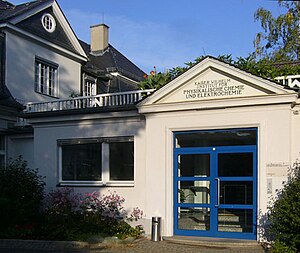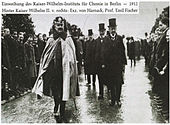Fritz Haber Institute of the Max Planck Society
| Fritz Haber Institute of the Max Planck Society | |
|---|---|
 Entrance Fritz Haber Institute with the inscription "Kaiser Wilhelm Institute for Physical Chemistry and Electrochemistry" |
|
| Category: | research Institute |
| Carrier: | Max Planck Society |
| Legal form of the carrier: | Registered association |
| Seat of the wearer: | Munich |
| Facility location: | Berlin-Dahlem |
| Type of research: | Basic research |
| Subjects: | Natural sciences |
| Areas of expertise: | Physics , surface chemistry , chemistry |
| Basic funding: | Federal government (50%), states (50%) |
| Management: | Hans-Joachim Freund (Managing Director) |
| Employee: | > 200 |
| Homepage: | www.fhi.mpg.de |
The Fritz Haber Institute of the Max Planck Society ( FHI of the MPG ) is a basic research institute that emerged from the Kaiser Wilhelm Institute for Physical Chemistry and Electrochemistry in Berlin-Dahlem . The main research interests are the understanding of catalytic processes at the molecular level and molecular physics. The institute currently consists of five departments (inorganic chemistry, interfacial science, molecular physics, physical chemistry and theory) and is headed by a board of directors.
history
In 1911 it was decided to establish a Kaiser Wilhelm Institute for Physical Chemistry and Electrochemistry, Fritz Haber was the founding director . In October 1912 the institute was inaugurated by Kaiser Wilhelm II after only eleven months of construction .
During the world wars, and especially during the Nazi era , the institute was subjected to the restrictions of the politics and military strategy prevailing at the time. In particular, the work of the institute during the First World War and in particular its director Fritz Haber laid the foundations for the development of gas wars . Following Haber's proposal, the institute was placed under the military on November 7, 1916. The institute delivered the research results for the first use of poison gas on April 22, 1915 near Ypres and Fritz Haber had personally checked the position of the gas bottles on the front line in advance. Research into the development of gas projectiles and the use of mustard gas (bis (2-chloroethyl) sulfide) has been carried out since 1916 , which was then used for the first time on July 12 and 13, 1917, also near Ypres.
After the end of the war, attempts were initially made to use the results obtained in the development of warfare agents for civil purposes in pharmacology and pest control. In cooperation with the Degesch company, the product Zyklon B was created . In the 1920s, in addition to Haber's research into the technical feasibility of extracting gold from seawater, more basic research was carried out at the institute. Fritz Haber resigned as director of the institute in 1933 after he was asked to dismiss Jewish employees (his own dismissal was initially not requested).
As his successor, Gerhart Jander was appointed acting director of the institute in 1933 . The conversion of the institute to research in the service of the National Socialist regime and the exchange of the entire workforce resulted in a sharp decline in publications. However, after Peter Adolf Thiessen's appointment as director in 1935, research returned to normal. Under Thiessen, who was himself a party member in the NSDAP , the institute was converted again to military tasks after the outbreak of the Second World War .
After the Second World War, the institute was continued together with several other Berlin Kaiser Wilhelm institutes under the umbrella of the German Research University Foundation .
In 1953, Max von Laue achieved the incorporation of the former Kaiser Wilhelm Institute into the Max Planck Society , and the institute was given the name that is still valid today. The institute was divided into various research departments. In 1957, the electron microscopy department (headed by Ernst Ruska ) was converted into an independent institute under the name of the Institute for Electron Microscopy at the Fritz Haber Institute. As part of a structural reform, the Fritz Haber Institute was divided into three sub-institutes from 1974: the Institute for Physical Chemistry, the Institute for Structural Research and the Institute for Electron Microscopy. In a further reform, these sub-institutes were dissolved again in 1980, the institute again consisted of departments as it had before 1974. At the same time, the institution of the institute director, which had been the norm up to then (for life or until retirement), was given up in favor of collegial management; The Executive Director of the institute is now appointed from among the departmental directors for a two-year term.
Nobel Prize Winner
Max von Laue received the Nobel Prize in Physics in 1914 for his work on the diffraction of X-rays on crystals . Fritz Haber received the Nobel Prize in Chemistry in 1918 “for the synthesis of ammonia from its elements”. Otto Hahn was awarded the Nobel Prize in Chemistry in 1944 for his work on nuclear fission , but the prize was not presented to him until two years later. In 1986 Ernst Ruska received the Nobel Prize in Physics for his work on the electron microscope . In 2007 Gerhard Ertl was honored with the Nobel Prize in Chemistry for research into surface chemical catalysts .
International Max Planck Research School (IMPRS)
The FHI operates the International Max Planck Research School Functional Interfaces in Physics and Chemistry . An IMPRS is an English-language doctoral program that enables a structured doctorate. Other partners in the IMPRS are the Humboldt University of Berlin , the Free University of Berlin , the Technical University of Berlin and the University of Potsdam . The spokesman for the IMPRS is Martin Wolf.
Directors
The former directors of the Kaiser Wilhelm Institute for Physical Chemistry and Electrochemistry and the Fritz Haber Institute are:
- Fritz Haber (1911-1933)
- Deputy Director: Herbert Freundlich (1919–1933)
- acting Otto Hahn (mid-July 1933 - mid-October 1933)
- Gerhart Jander (1933–1935)
- Peter Adolf Thiessen (1935–1945)
- Robert Havemann (1945–1948)
- Karl Friedrich Bonhoeffer (1948–1951)
- Max von Laue (1951–1959)
- Rudolf Brill (1959–1969)
- Heinz Gerischer (1969–1980)
In 1980, as part of a restructuring process, a college of directors was created in which the following people were or are members:
- Heinz Gerischer (1980–1986)
- Elmar Zeitler (1980–1995)
- Alexander M. Bradshaw (1980-1999)
- Jochen H. Block (1980–1995)
- Gerhard Ertl (1986-2004)
- Matthias Scheffler (since 1988)
- Robert Schlögl (since 1995)
- Hans-Joachim Freund (1995-2019)
- Gerardus Meijer (2002–2012, again since 2017)
- Martin Wolf (since 2008)
- Beatriz Roldán Cuenya (since 2017)
Head of department
- James Franck (1918-1920)
- Michael Polanyi (1923-1933)
- Rudolf Ladenburg (1924–1932)
- Kurt Ueberreiter (1943–1980)
- Ernst Ruska (1949–1974)
- Erwin W. Mueller (1950–1952)
- Gerhard Borrmann (1953-1970)
- Iwan N. Stranski (1954–1970)
- Kurt Molière (1953–1980)
- Rolf Hosemann (1960–1980)
External Scientific Members
The Max Planck Society appoints scientists who have achieved outstanding achievements in the research area of an institute as External Scientific Members.
Former External Scientific Members:
- Georg Menzer (1953–1989)
- Paul Harteck (1956–1985)
- Erwin W. Mueller (1957–1977)
- Helmut Ruska (1962–1973)
- Georg Manecke (1963–1990)
- Klaus Vetter (1966–1974)
- Immanuel Broser (1966-2013)
See also
literature
- Bretislav Friedrich, Thomas Steinhauser, Jeremiah James, Dieter Hoffmann : A hundred years at the interface of chemistry and physics: The Fritz Haber Institute of the Max Planck Society between 1911 and 2011 (with the help of Hans-Joachim Freund, Gerard Meijer , Matthias Scheffler, Robert Schlögl and Martin Wolf), De Gruyter, Berlin 2011, ISBN 978-3-11-219043-2 .
- Max Planck Society (ed.): Fritz Haber Institute of the Max Planck Society. Munich, 1999. (Reports and communications from the Max Planck Society, issue 99.1.), ISSN 0341-7778 .
- Working group of the ÖTV Berlin: "... in the peace of humanity, in the war for the fatherland ...". 75 years Fritz Haber Institute of the Max Planck Society. Notes on the past and present. Berlin 1986.
Web links
- Fritz Haber Institute of the MPG
- Publications of the Fritz Haber Institute in the MPG eDoc server (bibliography)
- History of the Fritz Haber Institute of the MPG
- A short biography of Fritz Haber, by Bretislav Friedrich (PDF; 3.12 MB)
- Otto Hahn as interim director of the KWI, from: History of the Kaiser Wilhelm Society during National Socialism (PDF; 484 kB)
Individual evidence
- ^ B. Friedrich, D. Hoffmann, J. James: One Hundred Years of the Fritz Haber Institute . In: Angew. Chem. Int. Ed. . 50, No. 43, 2011, pp. 10022-10049. doi : 10.1002 / anie.201104792 .
- ↑ Arne Schirrmacher: The Physics in the Great War , Physik Journal 13 (2014) No. 7, pp. 43–48.
- ↑ Margit Szöllősi-Janze, Fritz Haber 1868-1934, A Biography, Munich 1998, p 338
- ↑ Florian Schmaltz, warfare agent research in National Socialism, Wallstein Verlag 2005, p. 20f.
- ↑ Zyklon B - a pesticide becomes a murder tool
- ↑ FHI - Historical Review: The Years 1919-1933
- ↑ a b FHI - historical review: takeover of power by the National Socialists and World War II
- ↑ Working group of the ÖTV Berlin: "... in the peace of mankind, in the war for the fatherland ...". 75 years Fritz Haber Institute of the Max Planck Society. Comments on past and present , Berlin 1986, p. 43
- ↑ see homepage of IMPRS at http://www.imprs-cs.mpg.de/
Coordinates: 52 ° 26 '54.6 " N , 13 ° 16' 58.8" E
